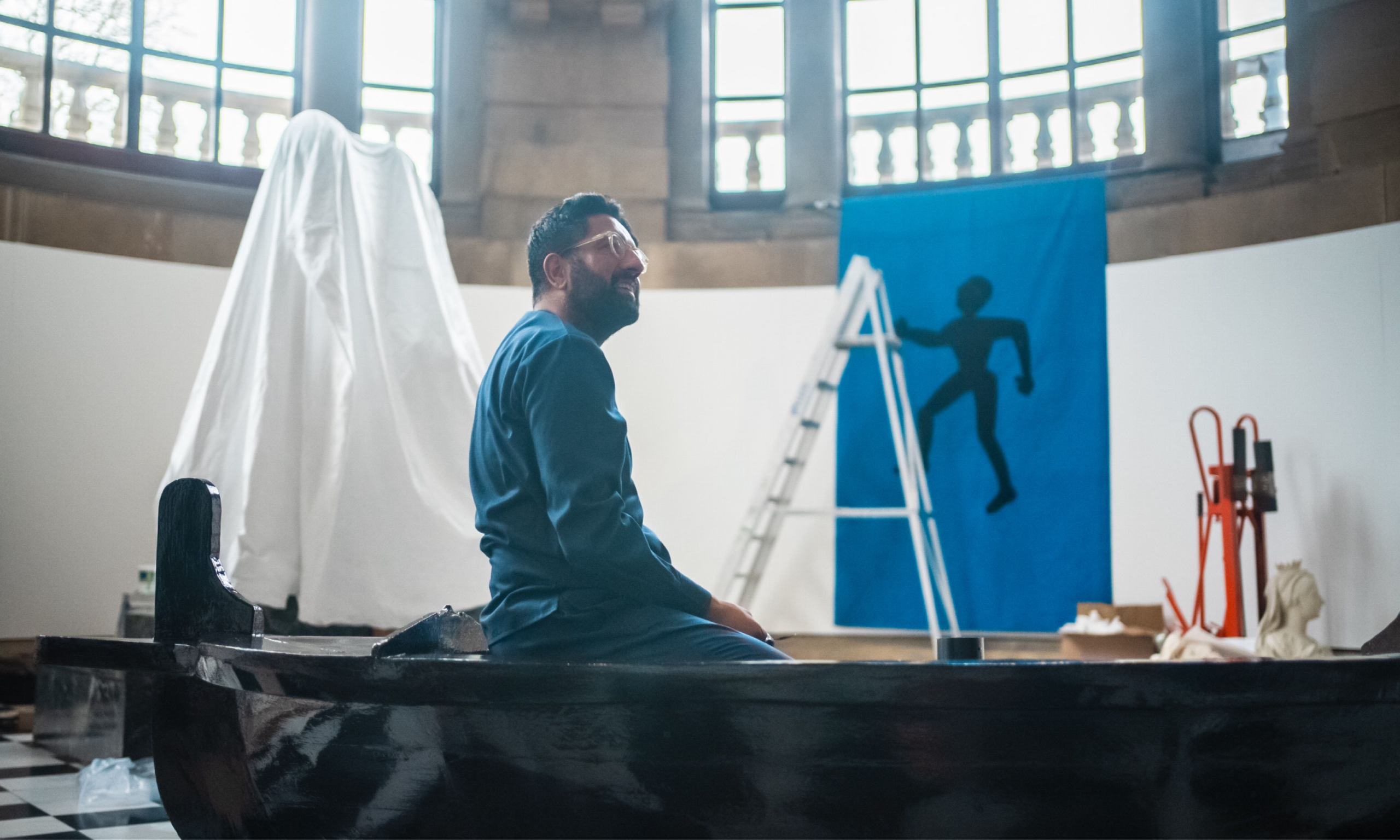Osman Yousefzada working on Where It Began at the Cartwright Hall Art Gallery Image: Courtesy of Bradford 2025 UK City of Culture
The artist Osman Yousefzada has installed a small boat at the heart of his new show, as political controversy rages over what to do about vessels of similar size carrying migrants across the Channel to the UK.
Where It Began, at the Cartwright Hall in Bradford, includes what appears to be a heavily lacquered rowing boat, as distinct from one of the inflatable dinghies familiar from TV news footage. “It’s definitely not Suella Braverman’s boat,” says Yousefzada, referring to the former home secretary, who is an advocate of sending migrants to Rwanda to deter others. After Braverman announced the “small boats” policy, the artist produced and distributed 5,000 billboards saying, “More Immigrants, Please”.
His boat in Bradford, which he has also exhibited at the Victoria & Albert Museum in London, is “a signifier, a Sufi idea of the boat as the means of taking you to the other side,” says Yousefzada, who first became known after designing clothes for stars including Beyoncé and Lady Gaga.
At Cartwright Hall, he explores Britain’s relationship with its immigrant communities through textiles and other objects like those which were all around him as he grew up in Birmingham with parents from Pakistan and Afghanistan. He has “bundled” or wrapped up sculptures of Queen Victoria and Diana the Huntress in fabrics which he associates with South Asia. He says, “Hiding the face and body inside the fabric is about inverting the idea of what’s important: it’s taking something from the margins into the forefront.”
An installation view of Where it Began by Osman Yousefzada at the Cartwright Hall Art Gallery Photo: © David Lindsay
When Yousefzada's father first arrived in the UK in the 1960s, he worked in a factory in Bradford. Now the artist is showing at a gallery in the city named after Edmund Cartwright, the inventor of the power loom, a pioneer of the textile industry, which once employed so many people from the South-East Asian diaspora in the mills of northern England, including Yousefzada Senior. That is one reason why the show is called Where It Began. Opening the exhibition, the artist called Cartwright Hall “a very masculine space, an edifice built by the men of the city. Its architecture imposes itself on you. But what happened and happens at the margin of this Grand Space?” he asks.
As for wrapping Queen Victoria in embroidered chintz, Yousefzada says, “It’s where our co-relationship of textiles began, the start of capitalism, colonialism—hopefully ending in community.”
But the artist did not sound particularly optimistic about community when he spoke to The Art Newspaper. “I feel that people are in encampments and we don’t recognise each other, each other’s humanity. There is a lot of Islamophobia, and the far right has taken up antisemitism. I just put my head in my hands—it’s a horrible time.”
After reports of universities cancelling courses in the creative arts and dwindling opportunities in the sector, is Yousefzada concerned for the next generation of talent? “It’s even this generation of artists: only 18% of people in creative jobs come from working class backgrounds. We don’t come from generational wealth; we don’t have that space. My mum had never been to a museum until I took her to an exhibition I had at the Ikon Gallery in Birmingham. I showed her a replica of a bedroom I had created in one gallery and she asked me, ‘Who sleeps here?’”
Where It Began is a curtain-raiser to Bradford’s tenure as City of Culture in 2025. Yousefzada says, “I used to come to Bradford as a kid. While some people were going to the Canary Islands, we would come here, for family occasions, funerals and births. It’s amazing that Bradford is City of Culture and I feel really honoured. It’s the place where my dad came to try and take root. As I see it, I try and plant trees for other people to sit under.”
• Where It Began, Cartwright Hall, Bradford, until 13 October

